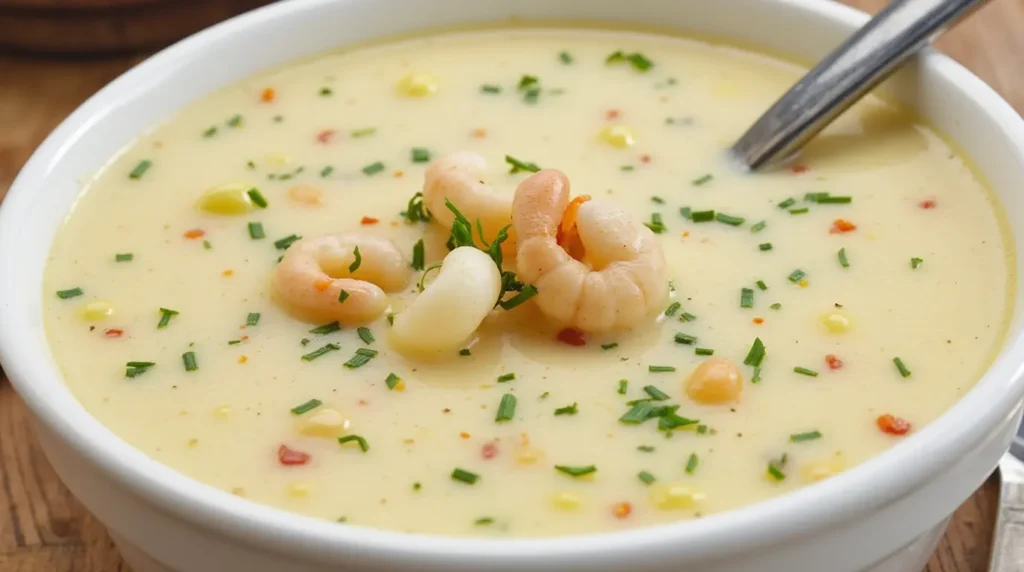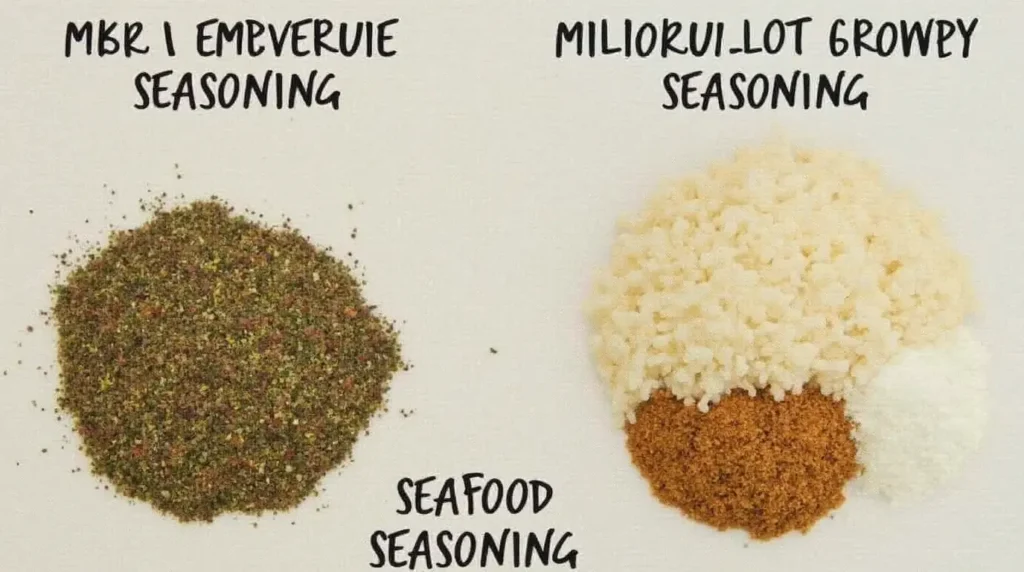Seafood chowder is the epitome of comfort food. It brings warmth, richness, and a depth of flavor that can transform an ordinary meal into something extraordinary. Whether you’re cooking for a cozy night in or preparing a hearty meal for a group, this classic seafood chowder recipe will have you savoring each spoonful. Best of all, it’s easy to prepare—made up of just five simple steps!
In this article, we’ll show you how to craft the perfect seafood chowder, providing expert tips and step-by-step instructions that ensure a delicious result every time. You’ll learn how to balance creamy textures, flavorful seafood, and aromatic vegetables, making it a dish your whole family will adore.
Table of Contents
Why Seafood Chowder? The Comfort Food You’ve Been Waiting For
When you think of comfort food, what comes to mind? For many, it’s warm soups and stews that offer both nourishment and emotional satisfaction. Seafood chowder fits the bill perfectly. It’s creamy, rich, and brimming with tender pieces of seafood—shrimp, scallops, or clams—all simmered in a savory broth. It’s the kind of dish that envelops you in warmth, reminding you of cozy kitchens, family gatherings, and the joy of sharing a hearty meal. Whether you’re looking to impress guests or simply indulge in a comforting bowl on a chilly evening, seafood chowder is always a good idea.

Ingredients You Need for Classic Seafood Chowder
The Building Blocks (H2)
A great seafood chowder starts with high-quality ingredients. While the recipe is simple, each ingredient plays a key role in creating the perfect balance of flavors. Here’s what you’ll need:
- Seafood: A mix of shrimp, clams, or scallops is ideal for a rich seafood flavor. Feel free to experiment with different types of seafood based on your preferences.
- Potatoes: Yukon Gold potatoes or other waxy varieties are best for chowder because they break down into a creamy consistency when simmered.
- Leeks and Onions: Leeks give a milder, sweeter flavor compared to regular onions, but onions work perfectly well too. Both add a subtle, savory depth to the chowder.
- Garlic: Minced garlic adds aromatic complexity and elevates the overall flavor.
- Butter and Cream: These ingredients provide the richness and creaminess that make seafood chowder so comforting.
- Broth: Seafood or vegetable broth forms the base of the chowder, giving it a savory depth. Avoid using chicken broth, as it doesn’t pair as well with seafood.
- Fresh Herbs: Thyme, bay leaves, and fresh parsley are ideal for seasoning and garnish.
- Seasonings: Salt, black pepper, and a pinch of cayenne pepper for subtle heat.
Cooking Tools (H3)
You’ll also need some basic kitchen tools:
- Large pot or Dutch oven
- Knife and chopping board
- Stirring spoon
- Ladle for serving
- Measuring cups and spoons
Pro Tip: For the best flavor, always use fresh seafood. If fresh isn’t available, frozen seafood works too. Just make sure to thaw it completely before adding it to your chowder.
Step-by-Step Instructions for Perfect Seafood Chowder
Now that we have everything ready, let’s dive into the five simple steps to create this classic seafood chowder.
Step 1: Prepare the Ingredients (H2)
Before you start cooking, it’s essential to prepare your ingredients. This includes cleaning, chopping, and dicing. Here’s a breakdown:
- Seafood: Peel and devein shrimp (if not pre-prepared) and cut them into bite-sized pieces. For clams or scallops, ensure they are cleaned and chopped as needed.
- Vegetables: Dice the potatoes into small cubes (about 1-inch pieces) for even cooking. Finely chop the onions, leeks, and garlic.
- Herbs: Chop the fresh parsley for garnish and strip the leaves off the thyme for seasoning.
Tip: If you have fresh thyme or rosemary, it adds an aromatic touch that enhances the flavor.
Step 2: Sauté the Aromatics (H2)
To begin, melt 2 tablespoons of butter in your large pot over medium heat. Once the butter has melted, add the chopped onions, leeks, and garlic. Stir occasionally until the vegetables have softened and the kitchen smells fragrant (about 4–5 minutes).
This sautéing step is crucial because it releases the natural sugars in the onions and leeks, which adds sweetness and depth to the chowder’s base.
Why This Matters: Sautéing also enhances the flavors and provides the foundation for a rich chowder.
Step 3: Cook the Potatoes and Add Broth (H2)
Once the onions, leeks, and garlic are softened, add the diced potatoes to the pot. Stir to combine, then pour in the broth. You’ll want enough broth to cover the vegetables (usually about 4 cups).
Bring the mixture to a boil, then reduce the heat to a simmer. Let it cook for about 10–12 minutes, or until the potatoes are tender. This step is important because it ensures the potatoes break down into a creamy texture, which helps thicken the chowder.
Pro Tip: Use a wooden spoon to occasionally stir, scraping up any bits from the bottom of the pot to prevent burning.
Step 4: Add the Seafood and Cream (H2)
Once the potatoes are soft, it’s time to add the seafood. Stir in the shrimp, clams, and/or scallops. Be sure to cook them gently to avoid overcooking, which can cause the seafood to become rubbery.
Next, pour in the heavy cream. This adds the rich, creamy texture that makes seafood chowder so indulgent. Let the chowder simmer on low heat for another 5–7 minutes until the seafood is cooked through. Add salt, pepper, and a pinch of cayenne pepper to taste.
Tip: To prevent curdling, avoid bringing the chowder to a rapid boil once the cream is added.
Step 5: Garnish and Serve (H2)
Now that your chowder is ready, it’s time to serve! Ladle the seafood chowder into bowls and garnish with fresh parsley and a sprinkle of thyme. You can also drizzle extra cream or sprinkle some grated cheese on top for added richness.
Serve with warm crusty bread or crackers to soak up all that creamy goodness.

Why You’ll Love This Classic Seafood Chowder Recipe
This seafood chowder recipe is a winner for several reasons:
- Quick and Easy: With just five steps, you can create a flavorful and comforting dish in under an hour. It’s perfect for a weeknight meal when you don’t want to spend hours in the kitchen.
- Rich and Creamy: The balance of seafood and creamy broth creates a satisfying dish that feels indulgent without being overly heavy.
- Versatile: You can easily adapt this recipe based on the seafood available to you. Shrimp, scallops, and clams are traditional, but feel free to experiment with lobster, crab, or fish for a different spin.
- Crowd-Pleaser: Whether you’re serving it to your family or a dinner party, this chowder will impress. It’s a dish that’s comforting, delicious, and visually appealing.
Serving Suggestions and Pairings
Seafood chowder pairs beautifully with simple sides that won’t overpower its flavors. Here are some ideas:
- Crusty Bread: A thick, hearty slice of sourdough or baguette is perfect for dipping into the creamy chowder.
- Salad: Pair with a light, fresh salad to balance out the richness of the chowder.
- Wine: A glass of white wine like Chardonnay or Sauvignon Blanc complements the dish well, enhancing the seafood’s flavors without being too strong.
Conclusion: Comfort in Every Spoonful
This classic seafood chowder recipe is sure to become a favorite in your kitchen. It’s simple to prepare yet packed with comforting flavors that will keep you coming back for more. Whether you’re a novice cook or an experienced chef, this recipe makes it easy to enjoy a rich, creamy bowl of seafood chowder in just five simple steps.
Call to Action: Ready to make your own seafood chowder? Try out this recipe tonight and experience the comforting flavors for yourself. Don’t forget to share your thoughts or any variations you’ve tried in the comments below!
FAQ
1. Can I use frozen seafood for this recipe?
Yes, frozen seafood works well in this recipe. Just make sure to thaw it thoroughly before adding it to the chowder.
2. How do I store leftover seafood chowder?
Leftover chowder can be stored in an airtight container in the refrigerator for up to 3 days. Reheat gently on the stove or in the microwave.
3. Can I make this chowder ahead of time?
Absolutely! This chowder tastes even better the next day as the flavors have had time to meld. You can make it in advance and reheat it when you’re ready to serve.

